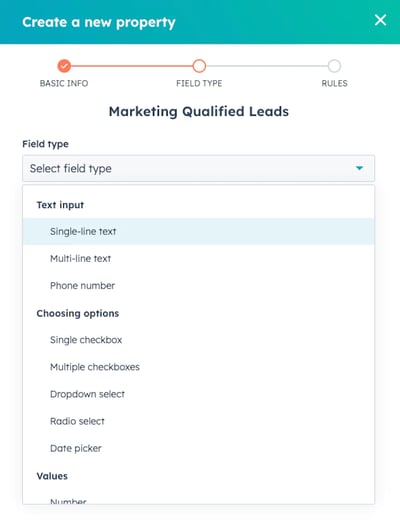Harnessing Custom Properties in HubSpot: A Deep Dive
Are you feeling frustrated by the limitations of default HubSpot data? Are you yearning for deeper insights and more targeted interactions with your audience?
Well, prepare to meet your secret weapon: custom properties.

Custom properties aren't mere data fields; they're keys to unlocking hidden dimensions within your contacts, companies, and deals. Forget one-size-fits-all; custom properties let you tailor your HubSpot to each individual, collecting and leveraging specific information that matters most to your business.
Imagine building a detailed profile for each contact, not just with basic demographics but with their preferred content topics, webinar attendance history, or niche product interests. Suddenly, your marketing efforts shift from generic blasts to personalized journeys. Tailor email campaigns, dynamically adapt website content, and implement laser-focused lead-scoring models – all fueled by the insights gleaned from custom properties.
What are Custom Properties?
Custom properties in HubSpot are user-defined fields that are pivotal in enhancing data management and personalization strategies. These fields allow users to capture, organize, and utilize specific information tailored to their unique business requirements. Unlike standard properties predefined by the platform, custom properties provide flexibility, empowering businesses to mold their data structure to fit their distinct needs.
-
Digital placeholders: Custom properties act as digital placeholders where users can store and retrieve detailed information about contacts, companies, deals, or other entities within the HubSpot ecosystem.
-
Flexibility in data types: Marketers can leverage custom properties to capture various data types, including text, date, number, and dropdown selections. This adaptability ensures that the collected data is diverse and aligns with the business's specific requirements.
Custom properties go beyond data storage, significantly impacting how data is organized and segmented. The benefits of custom properties in data management include:
-
Categorization and segmentation: Businesses can categorize contacts based on specific criteria, facilitating targeted communication and personalized marketing efforts. For instance, creating a custom property to capture the industry of a contact allows for more precise segmentation and content personalization.
-
Granular insight: Custom properties enable businesses to gain granular insights into their audience by capturing specific details that matter. This depth of information empowers marketers to refine their strategies and create more resonant messages.
Types of Custom Properties in HubSpot
HubSpot provides a range of custom property types to cater to diverse data requirements. Understanding these types is crucial for tailoring the data collection process:
-
Single-line text fields: Ideal for capturing brief textual information.
-
Multi-line text areas: Suitable for collecting more extensive textual information or comments.
-
Date pickers: Useful for recording date-related data, such as birthdays or renewal dates.
-
Dropdown menus: Allow users to choose predefined options, ensuring standardized data entry.

Uses and Benefits of Custom Properties
As we delve deeper into this blog, we'll explore these uses and benefits in more detail, but here's a preview:
-
Personalization: Custom properties are instrumental in personalizing marketing efforts by allowing businesses to tailor content based on specific data points.
-
Targeted communication: With custom properties, businesses can segment their audience more effectively, enabling targeted and relevant communication.
-
Workflow optimization: Custom properties are crucial in automating workflows, streamlining processes, and ensuring data accuracy.
-
Enhanced lead scoring: Businesses can optimize lead scoring models by incorporating custom properties, providing a more nuanced evaluation of leads.
-
Dynamic content creation: Custom properties are vital in creating dynamic, engaging content that resonates with different audience segments.
In subsequent sections, we'll elaborate on these uses and benefits, providing actionable insights for leveraging custom properties to their fullest potential within the HubSpot CRM platform.
Need guidance on how to migrate your CRM to HubSpot?
The Role of Custom Properties in Tailored Marketing
At the heart of tailored marketing lies the ability to personalize interactions with your audience. Custom properties are the backbone of this endeavor, allowing marketers to capture and utilize nuanced information about each contact. By creating custom properties that reflect individual preferences, purchase history, or engagement patterns, businesses can tailor their messaging to address each customer's unique needs.
For example, a custom property indicating the preferred communication channel of contact can inform marketers whether to engage through email, phone calls, or social media, enhancing the chances of meaningful interactions.
Targeting Specific Audiences Using Custom Property Data
Contact segmentation is a cornerstone of effective marketing; custom properties are pivotal. Businesses can categorize their audience based on specific criteria, enabling them to create targeted campaigns that resonate with particular segments. Whether it's industry, location, or product preferences, custom properties allow for granular segmentation, ensuring that marketing messages are not one-size-fits-all but tailored to each group's unique characteristics.
By leveraging custom property data, marketers can craft highly relevant content, promotions, and offers, increasing the likelihood of engagement and conversion within specific audience segments.
For effective personalization strategies, consider implementing the following custom properties:
-
Preferred communication channel: Create a dropdown menu custom property or a single-line text field to capture how contacts prefer to be contacted, allowing you to tailor communication methods accordingly.
-
Product preferences: Utilize the multiple-checkboxes custom property or a single-line text field to store information about specific products or categories that contacts have shown interest in or purchased, enabling personalized product recommendations.
-
Purchase history: Track and segment contacts based on their purchase history using a date picker custom property or numerical custom property to store details such as the last purchase date, total spend, or specific products bought.
To target specific audiences effectively, employ custom properties that cater to segmentation needs:
-
Industry affiliation: Create a dropdown menu custom property or a single-line text field to categorize contacts based on their industry, facilitating industry-specific marketing campaigns.
-
Geographic location: Capture the geographical location of contacts using a single-line text field or a dropdown menu custom property, enabling targeted promotions or event invitations based on location.
-
Product interest level: Implement a numerical custom property to rank contacts' interest in your products or services, allowing for more nuanced campaign targeting.
Leveraging Custom Properties for Email Marketing
Custom properties are pivotal in crafting personalized email campaigns that resonate with individual recipients. By incorporating specific details, such as the contact's name, preferences, or past interactions, into email content, marketers can create a more intimate and tailored experience. Utilize single-line text fields or dropdown menus as custom properties to capture information that adds a personal touch to your emails.
For instance, addressing recipients by their first name in the email salutation or tailoring product recommendations based on their preferences fosters a sense of connection and relevance, increasing the likelihood of engagement.
Dynamic Content Creation for Enhanced Engagement
Custom properties empower marketers to take email personalization to the next level by enabling dynamic content creation. With these fields, you can create content blocks that adapt based on a contact's specific attributes or behaviors. For example, dynamically showcase related products in your emails if you've captured product interests through custom properties.
Whether displaying location-specific offers, highlighting recent purchases, or tailoring content based on industry affiliation, dynamic content ensures that each email is a customized experience for the recipient. This boosts engagement and enhances the overall impact of your email marketing efforts.
To maximize the impact of custom properties of your email in HubSpot:
-
Segmentation: Use custom properties to segment your email list based on specific criteria, allowing for targeted and relevant email campaigns.
-
Automation: Implement workflows that leverage custom properties to automate email responses, ensuring timely and personalized communication with contacts.
-
Testing and optimization: Continuously test different personalization strategies using custom properties and analyze performance metrics to optimize your email campaigns over time.
Optimizing Lead Scoring with Custom Properties
Custom properties enhance lead scoring by allowing businesses to incorporate specific data points that reflect a lead's engagement, behavior, and characteristics. Custom properties enable a deeper understanding of a lead's unique attributes by going beyond standard lead scoring criteria, such as email opens or page visits.
For example, a numerical custom property indicating the lead's engagement level with specific product categories or a custom property reflecting their industry can significantly enhance the lead scoring process. This additional layer of information ensures that leads are evaluated not just on general interactions but on factors directly relevant to their potential conversion.
Setting up custom property-based lead scoring involves defining rules and assigning point values based on specific actions, attributes, or characteristics captured through custom properties. For instance, assign higher scores to leads who have engaged with content related to key product offerings or have indicated a high level of interest through custom properties.
Additionally, you can use custom properties to establish negative scoring rules, helping identify leads that may not align with your ideal customer profile or buyer persona. This ensures that your sales team focuses on leads that exhibit positive behaviors and match the specific criteria indicative of a qualified prospect.
Enhancing Workflows with Custom Properties
Custom properties act as key triggers and conditions within workflows, enabling businesses to automate actions based on specific data points. For instance, when a custom property, such as "Lead Status" or "Industry," is updated or meets specific criteria, workflows can automatically trigger actions like sending targeted emails, assigning tasks to team members, or updating contact records.
This automation saves time and ensures that processes are executed consistently, reducing the risk of manual errors and enhancing overall operational efficiency.
Integrating Custom Properties into HubSpot Workflows
Custom properties seamlessly integrate into HubSpot workflows, offering a versatile range of options for customization. Businesses can leverage custom properties when designing workflows to create highly personalized and contextually relevant experiences for contacts.
For example, if a custom property indicates a contact's subscription preferences, workflows can be tailored to send only relevant content, ensuring a more engaging and targeted experience. Custom properties thus become the driving force behind workflows that adapt dynamically to each contact's unique attributes and behaviors.
To optimize workflows with custom properties:
-
Detailed segmentation: Use custom properties to segment your audience within workflows, allowing personalized journeys based on specific attributes.
-
Data validation: Implement custom properties for data validation checks to ensure accurate and up-to-date information before triggering subsequent actions.
-
Multi-step personalization: Leverage multiple custom properties within a single workflow to create intricate, multi-step personalization that aligns with the complexity of your business processes.
Enhancing workflows with custom properties simplifies and automates processes and elevates personalization and precision in your marketing and sales efforts.
Troubleshooting and Common Challenges
While custom properties in HubSpot offer immense data management and personalization potential, encountering challenges is not uncommon. Identifying and addressing these issues promptly ensures a smooth workflow and accurate data interpretation.
-
Data inconsistencies: Inconsistent data entry practices can lead to variations in custom property values, impacting segmentation and personalization efforts.
-
The solution: data validation rules. Implement stringent data validation rules for custom properties to maintain consistency. Dropdown menus and predefined options help standardize data entry.
-
-
Workflow breaks: Errors in workflow setups or conditions may result in unintended consequences, such as miscommunication or incomplete automation.
-
The solution: regular audits. Conduct periodic audits of workflows and custom properties to identify and rectify issues. Regular reviews ensure that automated processes align with evolving business needs.
-
By proactively addressing potential challenges and implementing robust solutions, businesses can maximize the benefits of custom properties in HubSpot.
Advanced Tips and Tricks
Unlocking the full potential of custom properties in HubSpot requires a strategic approach that goes beyond basic implementations. Advanced tips and tricks empower businesses to leverage these data fields more effectively for unparalleled customization and optimization.
-
Property dependencies: Explore the feature of property dependencies to create dynamic data entry experiences, ensuring that custom properties adapt based on previous selections.
-
Calculated properties: Implement calculated properties to derive new insights automatically. For instance, calculate lead scores based on various custom property values to streamline the lead prioritization process.
-
Predictive analytics: Integrate predictive analytics tools with custom properties to forecast future customer behaviors. This advanced approach enables proactive marketing strategies based on anticipated trends.
-
Behavioral scoring: Develop custom properties that capture nuanced behaviors, allowing for more intricate scoring models. This goes beyond standard engagement metrics, providing a deeper understanding of individual interactions.
-
Cross-object custom properties: Extend the use of custom properties across different objects like deals, contacts, and companies. This cross-object functionality enhances data coherence and enables a holistic view of interactions.
-
API integrations: Leverage HubSpot APIs to integrate custom properties seamlessly with other tools and platforms. This enhances data synchronization and facilitates a unified approach to customer insights.
By delving into these advanced tips and tricks, businesses can elevate their use of custom properties to drive innovation and precision in their marketing and sales endeavors.
Are you looking for more hands-on help? As a HubSpot onboarding accredited organization, Aspiration Marketing expert resources offer expertise and personalized guidance to ensure seamless integration of advanced strategies like custom properties and more. Elevate your marketing and sales efforts today!
This content is also available in:
- German: Benutzerdefinierte Eigenschaften in HubSpot nutzen
- Spanish: Aprovechando las propiedades personalizadas en HubSpot
- French: HubSpot: Exploiter les propriétés personnalisées
- Italian: HubSpot: Sfruttare le proprietà personalizzate
- Romanian: Exploatarea proprietăților personalizate în HubSpot: O aprofundare
- Chinese: 利用 HubSpot 中的自定义属性:深入探讨









Leave a Comment